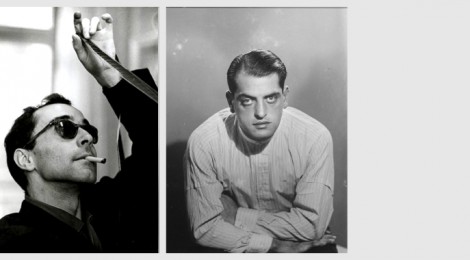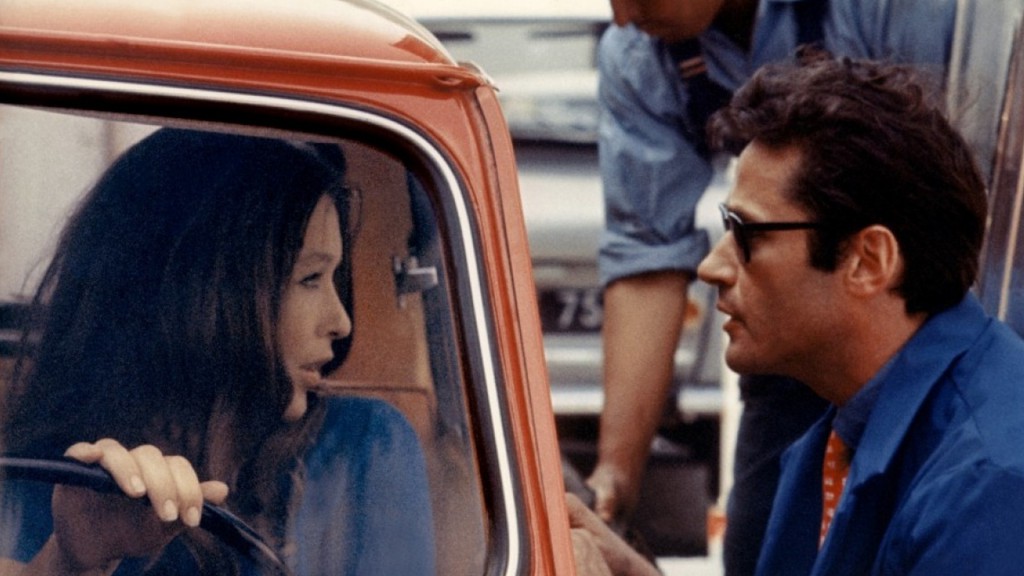
Housewife as Whore: 2 or 3 Things I Know About Jean-Luc Godard and Luis Bunuel
In 1967 two of the most significant figures in the history of cinema, both of whom were working at the height of their powers, released films on dramatically and coincidentally similar themes. Rarely does the cinema provide us with such perfect opportunities for directly (and appropriately) comparing the work of two very different auteurs, but the release, just two months apart, of Jean-Luc Godard’s 2 or 3 Things I Know About Her and Luis Bunuel’s Belle de Jour, provides just such an opportunity. To examine the similarities and differences between two such fascinating expositions on a near-identical theme gives us a wonderful insight into a pair of strikingly original minds.
Both films have, as their narrative core, the scenario of a middle-class Parisienne housewife, married to a good-looking, decent husband, living a comfortable bourgeois life, who spends part of her day as a prostitute in a Paris brothel. The reasons for their doing so is different, a difference that strikes at the heart of Bunuel and Godard’s intellectual approach, but the scenario remains the same. And in each case we are not just expected to accept this way of life as an inevitable consequence of the respective woman’s psychological or material circumstances, but to further accept it as a routine and really rather unremarkable everyday activity, commensurate with, and little distinguishable from, spending the afternoon socializing (in Bunuel) or choosing which detergents to buy (Godard). It takes place in daylight, involves dropping your children off at the crèche and keeping regular office hours, and is really no more out of the ordinary than going to the hairdresser or shopping with friends. Its morality (or lack of it) is never the point at issue – except as merely one facet in a far wider context.
But before we proceed further, perhaps it might be a good idea to briefly remind ourselves of the narrative contexts of each film.
In Belle de Jour, Catherine Deneuve plays Severine, the beautiful wife of a charming, good-looking and successful doctor, who is obsessed with a fantasy life involving abduction, flagellation, humiliation, bondage and rape. These fantasies are intercut with the story itself. Emotionally and sexually frigid in real life, aroused but simultaneously repelled by the seductive advances of a man she meets on a skiing holiday, she takes a part-time job in a chic bordello, insisting that she can only work from two o’clock until five (so as to be home when her husband returns from his practice). Her clients are mostly as unappetizing as one might expect, but then one afternoon two small-time gangsters pay a call. The younger of the two, Marcel, a cartoonish psychopath with metal teeth who carries a sword-stick and wears fetish-style black PVC, is (over and above the context of their meeting place) attracted to her and they become more than just whore and client – they become lovers. Marcel’s possessiveness ends with his waiting outside her apartment and shooting her husband when he returns home. He in turn is shot dead on the street by the police; the husband is left paralyzed… but then, in a final twist, we see him perfectly normal again, in the simple and wholly conventional setting of the Paris middle-class lifestyle they, and a million others, share.
2 or 3 Things I know About Her, having really no plot at all, is (at least superficially) simpler to précis. A married Frenchwoman, Juliette (played by Marina Vlady) lives with her husband and their two children in a high-rise apartment in a modern suburb of Paris. Every morning she drops off the daughter at a crèche run by the owner of a brothel, sleeps with clients for extra spending money, and goes home to her middle-class suburban home and husband in the evening. There are constant references to the sterility of suburban life, consumerism and the Vietnam War, plus a hoarsely-voiced commentary by Godard himself. The most well-developed and yet interpretationally-ambiguous character is a cup of coffee: shot in extreme close-up after having been stirred, its surface resembles both the fertilization of an embryo and the swirl of a distant galaxy. There is also a scene in which a client at the brothel insists that the girls parade in front of him wearing Pan Am and TWA flight bags over their heads. The plot, as I say, is minimal; like a play performed on a simple wooden stage, the props and the audience’s intellectual involvement are everything.
So much for two nearly identical plot devices. Now let us consider how we might interpret what are, in fact, two very complex (and very different) films.
The problem of interpretation of Belle de Jour can really be stated quite simply: where does fantasy end and reality begin? Severine’s fantasies would seem to be easy enough to spot, but Bunuel is careful to shoot them in exactly the same way he shoots the rest of the film. Stylistically, therefore, the film is seamless; might that not mean that it is all a fantasy in the heroine’s mind? What, then, are we to make of that celebratedly ambiguous ending? Does it represent Severine’s final and most perfect fantasy – that having reduced the constraining male figure to a state of total immobility and dependence, she can now mentally bring him back to normality whenever she wishes, thus having complete control over her marriage? We know, from a flashback scene where she refuses the sacrament as a child, that she has been raised a Catholic; this remains true even if the flashbacks are also fantasies, for you do not imagine refusing the sacrament if the sacrament was never offered. For a “normal” woman, to be trapped forever in a marriage to a paraplegic, divorce not being an option, would be an appalling prospect; for the extremely abnormal Severine, on the other hand, it might present a perfect scenario – her husband no more than a shop-window dummy against which to project her fantasies. But if we wish to follow this interpretation we must assume that the basic structure of the film is as it is presented: the overall story is reality (the shooting of the husband is “real”); the fantasy sequences are just that. Is this a problem? After all, it is how I suspect nearly everybody watching, certainly for the first time, interprets what they see. In fact, they have been conditioned to do so by the similar structure of countless previous films, not the least of which is Polanski’s Repulsion, also starring Deneuve. And yet, and yet… I am not quite convinced.
I am not quite convinced with – Marcel! Marcel, whom I described as cartoonish; Marcel, impossibly too good (as a villain) to be true. He belongs in some twisted psycho-sexual parody of a Batman comic. He’s wonderful, memorable, and – I don’t believe in him for a second! The grotesque metal teeth, the fetish gear, the stiletto hidden in his cane – these, surely, are the creations of a sexually deviant, masochistic imagination; just the sort of imagination, in fact, that Severine is supposed to have. In that case, if Marcel is a fantasy, everything is a fantasy; the obvious fantasies simply fantasies within a fantasy. No afternoons spent in the bordello; just a rather dull, rather ordinary marriage between two rather dull, rather ordinary people. The only “real” part of the film is the last couple of minutes. And I think Bunuel himself, probably unwittingly, gave us the precedent for this interpretation when, many years later, he was quoted as saying, “Give me two hours a day of activity, and I’ll take the other twenty-two in dreams.” Replace “dreams” with “sexual fantasies” and we might have a ready-made quote for Severine – plus a guide to the fantasy / reality ratio of the film’s running time.
One further point I would like to make, because it has a bearing on the above interpretation and leads us directly to the other subject of this essay. It concerns the death of Marcel, gunned down, as I have said, by the French police on a Paris street. That doesn’t ring true either, but in a different way from the character of Marcel himself. It comes across as nothing so much as an hommage (I hesitate to say parody) to Jean-Luc Godard himself. I find it impossible not to be instantly reminded of the (extremely contrived) endings of A Bout de Souffle and Vivre sa Vie. There is, to the best of my knowledge, no external evidence that this was indeed Bunuel’s intention (although we do know that he was familiar with and admired Godard’s work), but it adds, for me at least, another layer of artifice to the story, another sense that nearly the whole film is not intended to be “real.”
“I want to include everything… even groceries,” said Jean-Luc Godard, when talking about 2 or 3 Things I Know About Her. For a film that runs a modest 87 minutes, “everything” might seem a trifle overambitious, but what he certainly does do is force us to reflect on our preconceptions of normality and morality, and using, as a central character, a middle-class housewife who drops off her child and checks into a brothel as casually as another might sit behind the cash-desk of a local supermarket, is a masterstroke. To be more specific, the sheer blandness of her day is a masterstroke. It means that prostitution and buying supermarket products can be placed exactly in the same context, side by side. Which, now, is more immoral, Godard seems to be asking us: sleeping with strangers for money, or using that money to buy American goods that indirectly, but no less culpably, finance a morally unjustifiable war in Vietnam? Who is the greater exploiter of women: the pimp, the john, or the advertising executive who puts unnecessary products in seductive packaging to persuade hard-up housewives to buy what they don’t need and can’t afford? And is that packaging really any less ridiculous than a man “packaging” a prostitute by having her wear a Pan Am flight bag over her head? The answers to these questions, like the interpretation of that coffee cup swirl, are for us, the film-goer, to find. What is almost certain, however, is that we cannot condemn the central character, Juliette.
So what can we finally say? Perhaps only this: that in 1967 two of the greatest film-makers in the history of cinema produced films on an identical narrative premise. After that, we may just as well be comparing The Wizard of Oz with Citizen Kane. And that, for me, is the genius of it all. Like two jazz musicians improvising on the same basic tune, the results are so totally different from each other as to reaffirm our belief in the power of individual auteurs to stimulate us both aesthetically and intellectually in their own way. And let us not forget that both of these films have an enormous critical reputation. Amy Taubin, the Sight & Sound critic, writing for The Criterion Collection, described 2 or 3 Things I know About Her as “The greatest film by the greatest post-1950s filmmaker,” and Belle de Jour won both The Golden Lion and Best Film award at the Venice Film Festival. So permit me, almost like Severine herself, to be allowed the ambiguity of a double ending, and rewrite my concluding paragraph as follows:
So what can we finally say? Perhaps only this: that in 1967 two of the greatest film-makers in the history of cinema went mano a mano, head to head, each producing a masterpiece that fully bears comparison with the other. What is more extraordinary is that Bunuel made his first film, Un Chien Andalou, before Godard was born and, at the time of which we are writing, had made masterpieces in each of the previous five decades. For his part, Godard was on a run of extreme creative brilliance, producing at least one masterpiece a year since A Bout de Souffle in 1960. (He would finish 1967 with a consecutive run of 15 truly great films in eight years, one after the other, producing three in that year alone. Incroyable!). There comes a point where it is simply egregious to compare the work of one genius with another. We would do much better to raise a joint-pedestal and salute them both.



